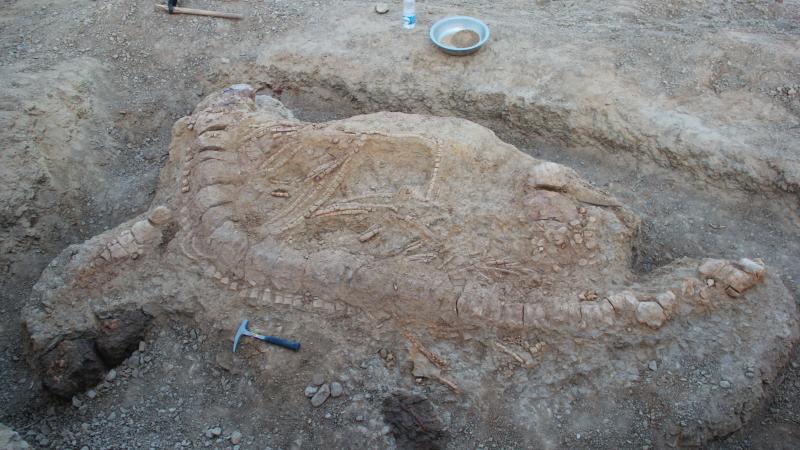
Scientists discover the first Ichthyosaur skeleton from India in Gujarat.
Ichthyosaurs were large marine reptiles which once lived in the Earth’s oceans. Though considered distant relatives of snakes and lizards, ichthyosaurs were not dinosaurs. So far, scientists have found fossil evidences of these giant ‘fish-lizards’ in parts of South America, North America and Europe. However, recently, paleontologists from India have discovered one such fossil in the Kachchh basin of Gujarat.
“No ichthyosaur remains have been reported so far from the Triassic rocks of India. From the Jurassic, the skeleton collected by us is the first from India. It is the oldest known occurrence of ichthyosaurs in India and is the only near-complete skeleton of ichthyosaur from India”, says Dr. Prasad Guntupalli, one of the authors of the study by a team of researchers from Delhi University, Manipal University, Christian-Albrechts-Universität zu Kiel, Friedrich-Alexander-Universität Erlangen-Nürnberg and Kachchh University. It was published in the journal PLOS ONE.
Ichthyosaurs are believed to have existed since the early Triassic Period (about 250 million years ago) until the Cretaceous period (about 90 million years ago). Their diversity was known to have been greatly affected by the end Triassic mass extinction -- a global extinction event that occurred about 200 million years ago. Though they made a comeback during the Jurassic Period (200-145 million years ago), they were eventually wiped out of the planet in the early Late Cretaceous (90 million years ago).
Explaining the timeline of ichthyosaurs, Dr. Guntupalli says, “Around 250 million years ago, all the continents that we see today, was assembled into a single supercontinent known as Pangaea. This supercontinent broke up in the late Jurassic (160 million years ago) into two major continental blocks known as Gondwanaland (comprising of South America, Africa, Antarctica, Australia, India and Madagascar) and Laurasia (consisting of North America, Europe and Asia)”.
Interestingly, most fossil remains so far of ichthyosaurs were found in Laurasian continents with limited occurrences from Gondwanaland. This discovery, one of the rare finds of near complete skeleton from the former Gondwanaland, has hence intrigued many. It was found in the lower Katrol Formation, a type of Jurassic rocks found in Kachchh. “The Upper Jurassic (152 million years) Katrol Formation is predominantly represented by sandstone and shale rocks”, says Dr. Guntupalli.
In the recent discovery, the researchers have presented a preliminary description of the ichthyosaur skeleton. The fossil remains at the excavation site included vertebral column, ribs, neural spines, gastralia (bones found between the sternum and the pelvis in reptiles) and two associated fins, alongside a part of the snout, jaws and other bone fragments. Further examination by the researchers revealed that the specimens belong to the family Ophthalmosauridae, which had a graceful dolphin-shaped body as long as 5.5 meters.

The discovery hints at the movement of animals between Indo-Madagascar and Mediterranean faunal provinces, during the Jurassic Period. Does it mean a possible seaway connected the two landmasses? If so, this seaway connected Tethys, an epicontinental sea that existed between Laurasia and Gondwanaland, which could have facilitated faunal exchanges between today’s Europe and Madagascar.
But, have you wondered how paleontologists excavate these fossil remains, study them to this depth, and find out who exactly these fossilized remains once were? “Fossils collected from the field are often embedded in rock matrix, as is the case with the Ichthyosaur skeleton we have collected from Kachchh. The first step we follow is to free the fossil specimen from rock matrix by cleaning with equipments like pneumatic tools and sand blaster, and sometimes by treating with mild acids”, explains Dr. Guntupalli, sharing some insights into his skillful work. “Following this, the fossils are treated with consolidants to strengthen fossils and finally deposited in a museum so that they are available for future study by any researcher and for display to the public”.
There have been quite a few related fossil discoveries in India. “Ichthyosaurs remains comprising of a few isolated teeth and fragmentary vertebrae, believed to be 100 million years old, have been discovered in the rocks of the Cauvery basin in South India”, says Dr. Guntupalli, adding that future explorations in remote areas such as Kachchh are expected to lead to more exciting discoveries of palaeontological significance.
